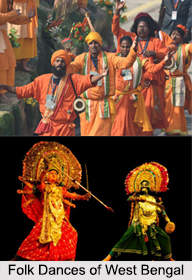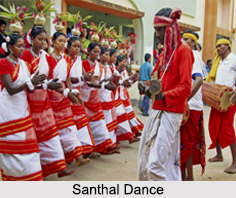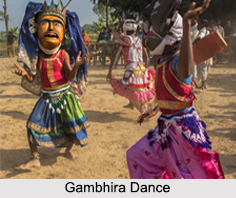 Folk Dances of West Bengal reflect the rich cultural heritage of the state. The different folk dances of this state are well-known for their fervour and beauty. Each and every region of West Bengal bears something distinct to exhibit. Dances are a part of tribal lifestyle. Folk Dances of West Bengal are performed in different parts of the state and during different occasions forming an environment of great festivity and entertainment. Folk dances in this state were initially either devotional or agricultural.
Folk Dances of West Bengal reflect the rich cultural heritage of the state. The different folk dances of this state are well-known for their fervour and beauty. Each and every region of West Bengal bears something distinct to exhibit. Dances are a part of tribal lifestyle. Folk Dances of West Bengal are performed in different parts of the state and during different occasions forming an environment of great festivity and entertainment. Folk dances in this state were initially either devotional or agricultural.
The major Folk Dances of West Bengal have been described below:
Brita Dance
Brita Dance, also known as "Vrita Dance" is one of the Folk Dances of West Bengal. It is mainly an invocation dance performed by women of West Bengal, who are unable to give birth to children. Only women perform this dance, as a sign of bowing down before God, after they give birth to the children. Thus, they offer their thankfulness to God after their wishes are fulfilled. Quite often, this dance is also performed after a recovery from contagious diseases.
Chhau Dance
Another major folk dance performed in the state of West Bengal is the Chhau Dance. It is one of the famous tribal martial dances in India. Since this form of folk dance is imagined to have its origin at the Purulia district in the state of West Bengal, it is thus known as Purulia Chhau in Bengal. This dance is a mask dance which is performed only by the male dancers in Bengal. It is also a mythological dance, as it is mainly based on different episodes of the great epics of Mahabharata and Ramayana.
 Nabanna Dance
Nabanna Dance
Nabanna is a ritualistic dance performed after the autumn harvest. It is part of a religious ceremony associated with cultivation and harvesting. The dance is an expression of the happiness of the farmers" families after a successful harvest.
Gambhira Dance
Gambhira Dance is one of the Folk Dances of West Bengal which acquired a significant position in the culture of this state. Gambhira dance is an example of one of the most famous devotional folk dances of Bengal. This folk dance is performed specially during Charak festival and it is very much popular in North Bengal, especially in Malda district. It is a solo performance whereby the participant wears a mask while performing the dance.
Tusu Dance
Tusu Dance of Birbhum district is performed in the Pausha month of Hindu calendar. Tusu is a tribal folk dance, which is performed by both men and women. It is also popular in Purulia and Medinipur and performed during the harvest festival to celebrate the coming crop.
Santhal Dance
Santhal Dance is a very popular folk dance of West Bengal. It is a group dance performed by Santhal tribes during all special festivals and occasions. This dance not only reveals the culture or traditions of the local tribes but also showcases the strength of unity. Dances are usually performed on a full moon night and are connected with the celebration of certain rituals. The dancers stand in a line holding hands move to the rhythm of the Madol.
 Lathi Dance
Lathi Dance
Lathi Dance is another notable form of folk dance which has a very different art of expression. This dance is performed to express different situations like remorse, celebration, anger, pain or love. The move of the dancers of Lathi Dance defines clearly each and every expression in a beautiful way. This dance is performed in the first 10 days of the Muslim festival of Muharram.
Rabha Dance
Rabha Dance is another famous folk dance of West Bengal which is performed in the state"s northern parts. This folk dance is performed by women belonging to Rabha community. The Rabha dance is rhythmic and colourful and it is executed with melodious music. The themes of this folk dance cover the chores, several festivals and daily life.
Jhumur Dance
Jhumur Dance is one of the liveliest folk dances of West Bengal. Several variations of this dance have emerged from Purulia, Birbhum, Bankura and Bardhaman. The dance is performed by girls while the boys play the Dhol or Madol and is accompanied by fast-paced and cheerful Jhumur songs.
Ganga Baidya
Ganga Baidya is a folk dance of the snake charmers of Bengal. The dance gives expression to the daily lives, customs, hopes and aspirations as well as the pains and tribulations of this sect of people of rural Bengal.
Apart from these, there are many other folk dances of West Bengal which includes Baul, Mundari dance, Gajan dance, Raibenshe dance, Ranapa dance, Dhali and Paika Nritya, Natua dance, Kirtan dance, Chaibari Nritya, Domphu Nritya, Kukri Nritya, Mech dance, Bhadu dance, Dhamail, Noila Broto, Baromashya and Bou Nritya. These dances are performed round the year on various occasions, at fairs and festivals and religious conglomerations.



















